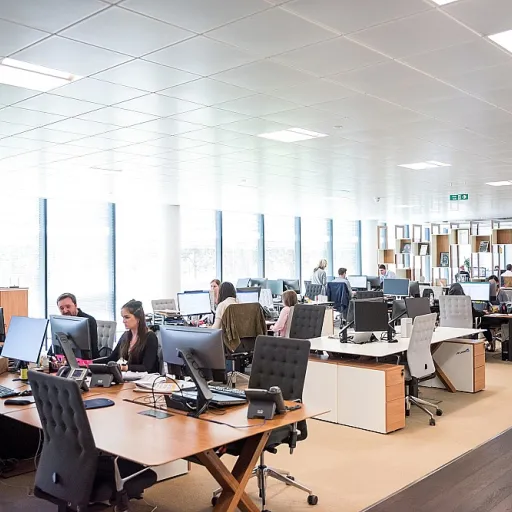
Understanding Centralised HR Systems
Grasping the Benefits of Integrated Systems
Centralized human resource systems, commonly known as HRIS, are transforming how organizations manage their workforce. By adopting a single central system, organizations can streamline various HR processes and improve overall workforce planning. This results in significant improvements in data management and accessibility, leading to effective decision making. A centralized system offers a robust operating model that integrates multiple HR functionalities into a unified platform. This integration ensures that employee data is managed efficiently, enhancing the accuracy and reliability of information. Consequently, leaders can focus on strategic initiatives that drive long-term performance without being bogged down by data silos typical in decentralized systems. Furthermore, these systems foster a collaborative environment among various departments and HR teams. By centralizing data, teams can work together seamlessly without the barriers often posed by disparate systems. Improved collaboration supports better recruitment processes, ultimately enhancing the employee experience. For more insights on streamlining candidate sourcing processes, you can explore essential recruiting software for emerging startups. This resource offers practical guidance on the tools that enhance recruitment effectiveness in fast-paced environments. In conclusion, centralized HR systems set the stage for future-focused workforce planning, providing a bedrock for strategic human resource management. The efficiency gained from such systems translates into substantial cost savings and sets organizations on a path toward sustainable employee engagement and superior performance management.Streamlining Candidate Sourcing Processes
Optimizing Candidate Discovery
In today's rapidly evolving HR landscape, streamlining candidate sourcing processes has become a crucial task for organizations aiming to stay ahead in talent acquisition. The implementation of centralized HR systems can significantly help organizations manage and enhance their sourcing efforts, ultimately leading to more efficient recruitment.
By centralizing recruitment operations, organizations can establish a more organized and cohesive approach to manage their talent pipelines. This move facilitates the staffing teams in working towards shared strategic initiatives while strengthening the organizational operating model. A single, centralized resource system not only provides cost savings but also enhances employee engagement by offering a more seamless experience for both recruiters and candidates.
Efficiency through Automation
The integration of management software and human resource systems can greatly enhance the performance of an organization's recruitment efforts. By leveraging automated processes, recruiters can spend less time on administrative tasks and focus more on strategic decision-making. This shift not only boosts performance but also sets the groundwork for future innovation in candidate sourcing.
Furthermore, this transition to a centralized system ensures compliance with management protocols and helps different departments align under a unified set of guiding principles. It encourages a smoother flow of information between teams, supporting data-driven initiatives that improve recruitment outcomes and workforce planning.
Improved Candidate Matching and Engagement
Centralized HR systems enable organizations to harness the power of analytics, thus facilitating better candidate matching and improving the overall employee experience. These systems empower HR leaders to make informed decisions by providing insights into candidate data, allowing for a more personalized approach during the recruitment process.
In the quest for heightened efficiency, the centralized approach not only paves the way for improved candidate sourcing but also creates opportunities for decentralized ways of working to thrive within organizations. As a result, HR departments can better attract top-tier talent, thanks to enhanced collaboration and optimized processes.
For a deeper understanding on how centralized HR systems can revolutionize your candidate sourcing strategy, explore the benefits of location scouting software as a service and its impact on contemporary recruitment.
Improving Data Management and Accessibility
Optimizing Data Management for HR Success
A central facet of effective HR operations is the management and accessibility of data. Centralised HR systems play a pivotal role in streamlining this aspect, as they allow an organization to seamlessly integrate diverse data-driven processes. By implementing these systems, HR departments can better manage information across various channels, paving the way for optimized recruitment and other HR functions. Centralized platforms significantly enhance data management by providing a single central repository for employee data. This not only facilitates better workforce planning and staff allocation, but it also ensures compliance with management software requirements. Through advanced human resource systems, HR teams can efficiently monitor performance management metrics, improving the overall workforce experience. Here are some primary benefits of using centralized systems for data management:- Improved Data Accessibility: Organizations can easily share and access crucial workforce data, enabling more informed decision-making processes.
- Enhanced Compliance: With consistent data management, organizations can adhere to compliance standards more effectively.
- Streamlined Processes: Centralized data systems help remove redundancies often seen in decentralized setups, allowing for more efficient ways of working.
Enhancing Collaboration Among HR Teams
Boosting Interdepartmental Coordination
Centralized HR systems play a crucial role in enhancing collaboration among various HR teams within an organization. By providing a single, unified platform, these systems bring together different departments, such as recruitment, performance management, and workforce planning, allowing them to work in harmony. A centralized approach promotes better communication and alignment across teams. With a common platform for data sharing and collaboration, HR professionals can easily access and analyze important workforce data. This leads to efficient decision making and ensures better alignment with the organization’s strategic initiatives. Here are some key factors contributing to improved collaboration with centralized HR systems:- Integrated Workflows: Centralized HR systems streamline workflows across different teams, allowing them to share resources and information seamlessly. This reduces redundancy and fosters collaboration.
- Data Accessibility: Centralized systems improve data accessibility, empowering HR teams with the information they need for effective people management. This data-driven approach enhances the quality of decision making and ultimately boosts employee engagement.
- Enhanced Communication: With all HR processes under one roof, communication between departments becomes more straightforward, making it easier to align on goals and driving efficiencies.
- Support for Strategic Initiatives: Centralized systems help HR leaders focus on future growth by providing tools for long-term planning, cost savings, and the optimization of workforce management practices.
Leveraging Analytics for Better Recruitment Outcomes
Utilizing Data-Driven Insights for Recruitment Success
In today's competitive job market, leveraging analytics is crucial for enhancing recruitment outcomes. Centralized HR systems provide a single central repository of data, which is instrumental in guiding strategic initiatives and improving decision making. By utilizing data-driven insights, organizations can refine their recruitment processes, ensuring they attract and retain top talent.
Analytics in a centralized system allows HR leaders to monitor key performance indicators (KPIs) related to recruitment. This includes tracking the time-to-fill positions, cost-per-hire, and candidate quality. Such metrics are essential for workforce planning and optimizing the recruitment strategy. With a comprehensive view of these metrics, organizations can identify trends and make informed decisions to improve their recruitment outcomes.
Enhancing Employee Experience and Engagement
Centralized HR systems also play a pivotal role in enhancing the employee experience and engagement. By providing a seamless and efficient recruitment process, organizations can ensure a positive experience for candidates from the outset. This not only improves the organization's reputation but also increases the likelihood of securing high-quality candidates.
Moreover, by integrating performance management and workforce planning into the centralized system, HR teams can better align recruitment efforts with long-term organizational goals. This alignment ensures that the recruitment process supports the overall operating model and strategic initiatives of the organization.
Fostering Collaboration and Compliance
Centralized HR systems facilitate enhanced collaboration among HR departments and teams. By providing a unified platform for data management and sharing, these systems ensure that all relevant stakeholders have access to the necessary information. This fosters a collaborative environment where HR teams can work together effectively to achieve recruitment goals.
Additionally, centralized systems help organizations maintain compliance with relevant regulations and standards. By ensuring that all recruitment processes are documented and accessible, organizations can demonstrate compliance and mitigate potential risks.
In conclusion, leveraging analytics through centralized HR systems is a powerful way to enhance recruitment outcomes. By focusing on data-driven insights, improving employee experience, and fostering collaboration, organizations can optimize their recruitment processes and achieve long-term success.












